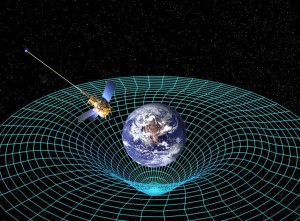Trying to Handle the Truth: Fitting Natural Law into Money
Natural law sounds, well, old. It’s outdated, old fangled, medieval, dusty, and quite frankly, irrelevant.
This is the case until we make a subtle distinction between the objects of a science and the methods of a science.
Let me begin with a simple illustration:
In the 18th Century, the educated world had a Newtonian understanding of the law of gravity. That meant that two objects would exert a force of attraction on one another, and this force ultimately depended on the objects’ sizes and the distance between them. The objects moved toward each other in straight lines, within an absolute and fixed universe.
Today, the educated world has an Einsteinian understanding of the law of gravity, which no longer treats space and time as two separate and absolute categories within the astronomical spectrum, but rather as interwoven into a single continuum known as space-time. So instead of two Newtonian objects attracting one another along a straight line because of their supposed innate force known as gravity, we now understand that massive objects cause distortions in space-time. If we roll a marble across a trampoline, and set a heavy rock in the middle at the same time, the marble will roll toward the middle because of the dimple caused by the rock’s weight. The rock is a planet, the marble a satellite, and the trampoline the fabric known as space-time. Gravity no longer deals with straight lines, but rather with curvature in the space-time continuum.
But regardless of these explanations, jumping from the 15th storey of a building onto a cobblestone road either in the 18th century, or today, would get you the same result: paralysis, and almost certain death.
The object of the science, in this case, is the motion of an object toward the earth. And that hasn’t changed in the last few millennia. Nor do we have any reason to believe that it will change any time soon. The method of the science is what we use in order to study and understand the object. So we understand the universe differently now, but it’s still the same universe with the same laws that astronomers were trying to understand 2,500 years ago.
And so what’s the point of my astronomy lesson, boys and girls?
There are immutable laws that govern the Universe, as there are laws that govern our micro and macro economies.
Exhibit A: If you spend more than you earn indefinitely, you will have to file for bankruptcy. Even if you miraculously won the lottery one day and invested a good amount of your winnings, if you still spent more than what your returns were bringing you, you would have to continue dipping into originally invested capital, and you would eventually deplete your funds.
Does it sound impossible? In his autobiography, Quiet Strength, former NFL and Superbowl winning coach, Tony Dungy, attests to the fact that 70-75% of NFL players end up bankrupt only a few years after their retirement. Why? See Exhibit A.
In addition to Exhibit A, there are 12 other economic laws that govern investor behaviour, spelled out for you by behavioural finance expert, Dr. Daniel Crosby. Check them out!








